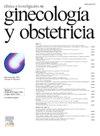孕期超声波扫描的最新进展
IF 0.1
Q4 OBSTETRICS & GYNECOLOGY
Clinica e Investigacion en Ginecologia y Obstetricia
Pub Date : 2024-09-25
DOI:10.1016/j.gine.2024.100997
引用次数: 0
摘要
第二孕期超声波检查是一项标准化的孕期检查,应常规提供给所有孕妇,用于监测胎儿生长和筛查畸形。超声波检查应在妊娠 18-24 周之间进行(西班牙为妊娠 18+0-22+0 周),由经过培训的人员使用适当的设备进行。报告应反映胎位和胎动、生物测量、羊水量、胎盘位置和外观以及胎儿形态。胎儿解剖应包括头部(骨化和神经电图)、颈部(剔除肿块)、胸腔及其内容物、腹部和骨盆(研究胃、脐静脉、脐带入口、肾脏、膀胱)、脊柱(矢状面、冠状面和轴状面)、四肢(三节、运动)和生殖器。应特别注意胎儿心脏检查(坐位、四腔切面、左心室和右心室流出道切面、三血管切面、三血管和气管切面)。经脑室、经小脑和经头颅平面的神经超声检查也很重要。本文章由计算机程序翻译,如有差异,请以英文原文为准。
Update on second trimester ultrasound scanning in pregnancy
Second trimester ultrasound is a standardised examination in pregnancy that should be routinely offered to all pregnant women, both for monitoring foetal growth and for screening for malformations. It should be performed between 18 and 24 weeks (in Spain from 18 + 0 to 22 + 0 weeks of gestation), by trained personnel and with appropriate equipment. The report should reflect foetal position and movements, biometry, amount of amniotic fluid, placental location and appearance, and foetal morphology. The foetal anatomy should include the study of the head (ossification and neurosonography), neck (discarding masses), thoracic cavity and its contents, abdomen and pelvis (studying stomach, umbilical vein, entrance of umbilical cord, kidneys, bladder), spine (in sagittal, coronal and axial planes), extremities (three segments, movement), and genitalia. Special attention should be paid to foetal heart examination (situs, four chamber view, left ventricular and right ventricular outflow-tracts, three-vessel and three-vessel-and trachea views). Neurosonography is also important with the transventricular, transcerebellar and transthalamic plane.
求助全文
通过发布文献求助,成功后即可免费获取论文全文。
去求助
来源期刊

Clinica e Investigacion en Ginecologia y Obstetricia
OBSTETRICS & GYNECOLOGY-
CiteScore
0.20
自引率
0.00%
发文量
54
期刊介绍:
Una excelente publicación para mantenerse al día en los temas de máximo interés de la ginecología de vanguardia. Resulta idónea tanto para el especialista en ginecología, como en obstetricia o en pediatría, y está presente en los más prestigiosos índices de referencia en medicina.
 求助内容:
求助内容: 应助结果提醒方式:
应助结果提醒方式:


